
On the night of Aug 13/14, 2020, under good conditions, I acquired a few (underexposed) images of Nova Cas 2020, as a first attempt at measuring this recent eruption. Alas, I didn't choose the exposure time wisely, and dawn arrived before I could make adjustments, so my measurements are poor. Better luck next time.
I also acquired images of Ross 248 and GX And for our continuing study of their parallax and proper motion. On this evening, I acquired images in both the usual R-band filter, and also in the V-band. The results suggest that the two filters yield results with the same position and similar precision -- good to know!
You can find some basic information on this star at the the AAVSO's Alert Notice page for it.
The main setup was:
Notes from the night:
The object is at
RA = 00:11:42.97 Dec = +66:11:19.0 (J2000)
An AAVSO chart of the field is shown below. The size of the chart is about 30 x 30 arcminutes.

The table below is from the AAVSO; see their full table with more information.

I used the star labelled "87" to calibrate my V-band measurements; based on two other stars, the calibration is good to about 0.05 mag, though I didn't include any color terms.
As mentioned earlier, this exposure time was way too short to collect enough photons for a really good measurement. The text file below shows my so-so results.
# Measurements of N_Cas_2020 made at RIT Obs, UT 2020 Aug 14, # in fair conditions, # by Michael Richmond, # using Meade 12-inch LX200 and ATIK 11000. # Exposures 5 seconds long, V filter. # Tabulated times are midexposure (FITS header time - half exposure length) # and accurate only to +/- 1 second (??). # 'mag' is a differential magnitude based on ensemble photometry # using a circular aperture of radius 4 pix = 5.0 arcseconds. # which has been shifted so AAVSO 000-BNP-448 has mag=8.711 # which is its V-band magnitude according to AAVSO. # # UT_day JD HJD mag uncert Aug14.39378 2459075.89378 2459075.89425 12.681 0.057 Aug14.39395 2459075.89395 2459075.89442 12.694 0.056 Aug14.39412 2459075.89412 2459075.89459 12.662 0.058 Aug14.39428 2459075.89428 2459075.89475 12.603 0.067 Aug14.39446 2459075.89446 2459075.89493 12.693 0.056
This is one of the stars that a capstone student may study over the next year in a project involving parallax. Ross 248 is a relatively faint red star surrounded by many other stars of similar brightness, so it's a good candidate for high-precision parallax measurements.
These observations involved:
The object is (currently) near position
RA = 23:41:55.27 Dec = +44:10:06.38 (J2000)
A chart of the field is shown below. The size of the chart is about 41 x 27 arcminutes. The noisy area at right (West) is the shadow of the guider's pickoff mirror.
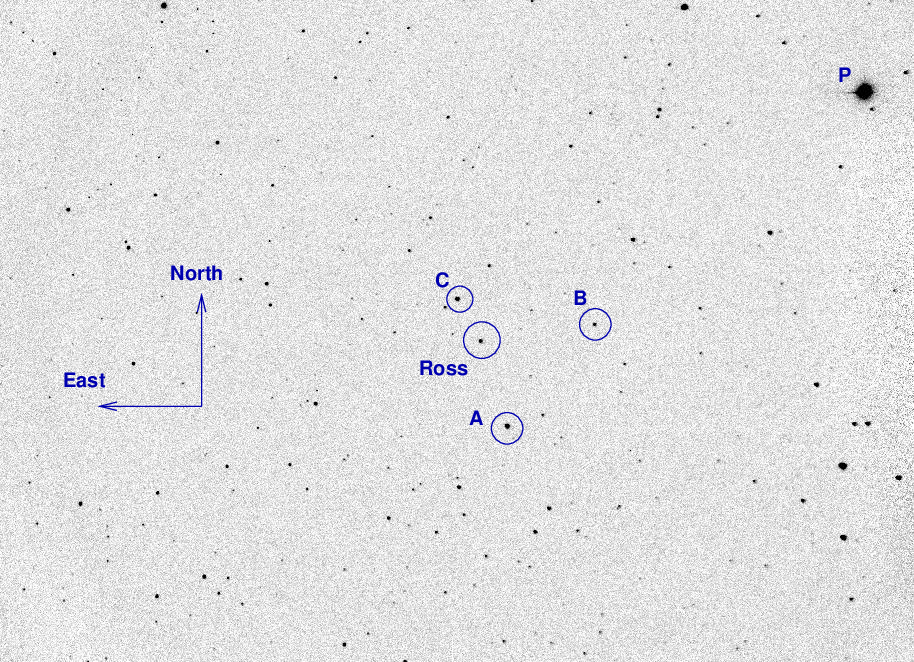
I've marked the location of several comparison stars.
star UCAC4 B V r ------------------------------------------------------------------------- A UCAC4 671-120730 12.617 10.689 B UCAC4 671-120688 C UCAC4 671-120749 10.987 10.663 P kappa And 4.06 4.14 --------------------------------------------------------------------------
I took a photo of the finder TV's screen when pointing to Ross 248; this could be a useful reference for the future:
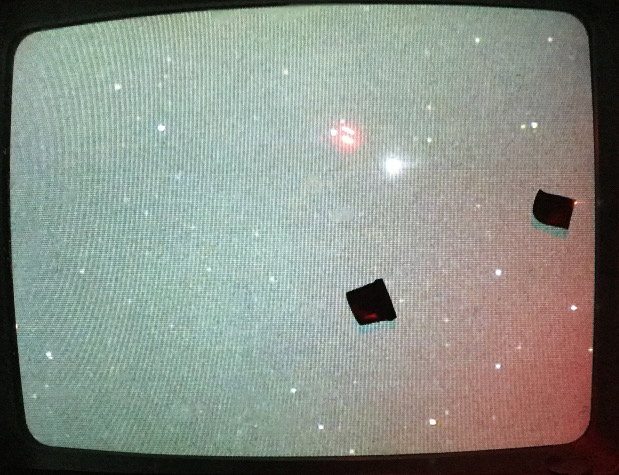
The dark current was normal this evening:

I took a series of 50 exposures of the field using the R-band filter AND the V-band filter, too. and an exposure time of 20 seconds. The signal-to-noise of the target is still considerably lower than I'd like, but that's in part due to its fading.
The sky value shows that the sky was mostly clear, with a small bump due to some light cloud.
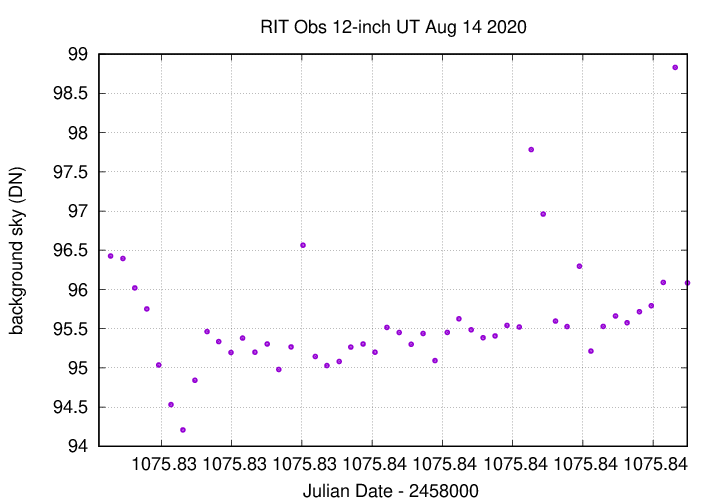
The number of objects detected.
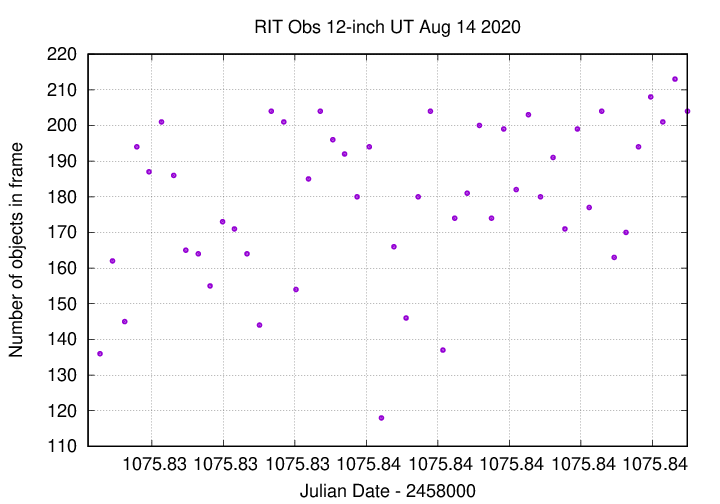
I used an aperture with radius 4.0 pixels tonight, as usual.
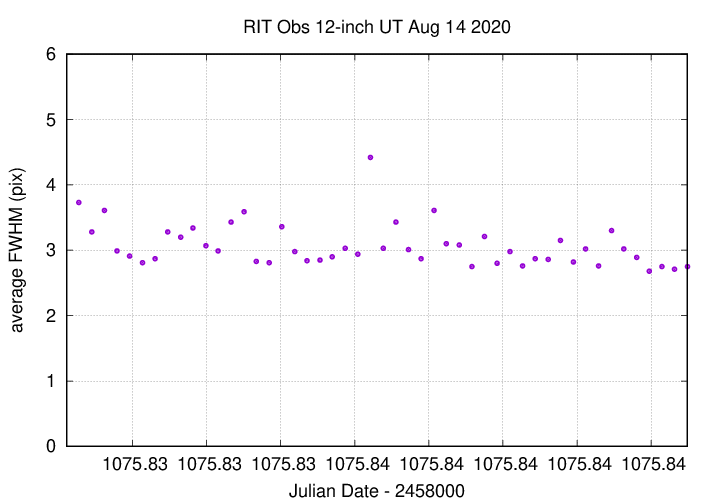
This is my twelfth measurement of Ross 248. The motion is starting to show clearly, at last, negative in both RA and Dec.
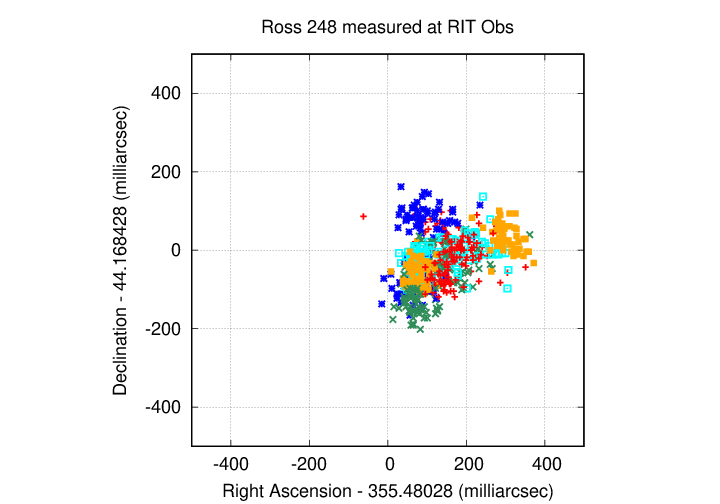
As mentioned earlier, the V-band and R-band positions were the same within 1-sigma, and the uncertainties were very similar: about 25-30 mas in each direction for both filters. Good.
Like Ross 248, GX And is a nearby (binary) star which will be the target of a parallax project in the coming year. One of the two components is bright -- about mag V = 8 -- so one must use short exposures to prevent it from saturating the detector. That may mean that this system isn't as easy to measure as Ross 248 or some others.
The object is currently close to this position:
RA = 00:18:28.4 Dec = +44:01:31 (J2000)
but it does have a very high proper motion.
A chart of the field is shown below. The size of the chart is about 41 x 27 arcminutes. The noisy area at right (West) is the shadow of the guider's pickoff mirror.
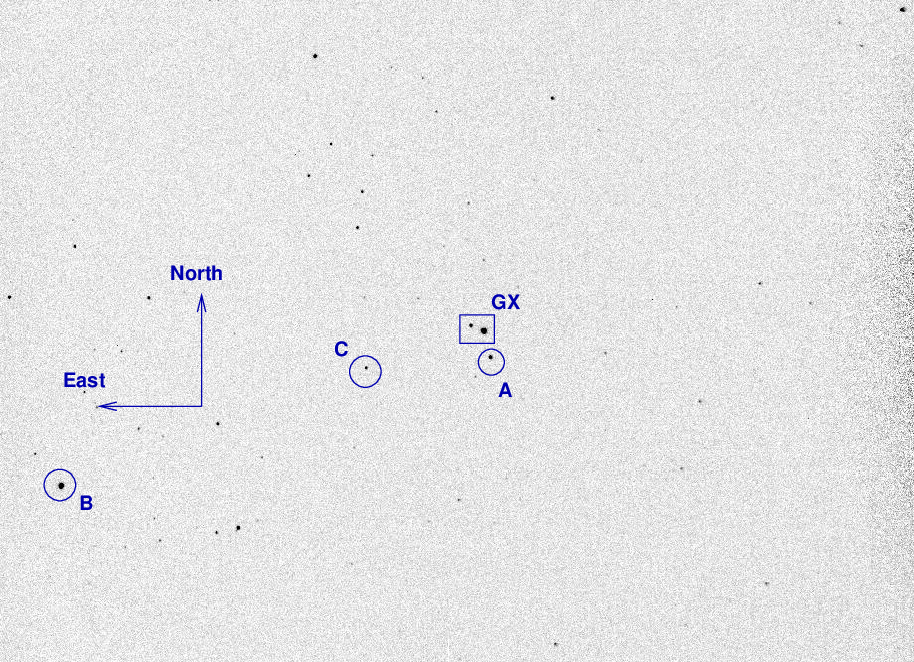
The two components of the GX And binary sit inside the box. I've marked the location of several comparison stars as well.
star UCAC4 B V r ----------------------------------------------------------- A 671-001473 9.939 9.790 B 670-001639 9.413 8.472 C 671-001509 12.712 11.421 11.001 -----------------------------------------------------------
I took a photo of the finder TV's screen when pointing to GX And; this could be a useful reference for the future:

I took one series of 50 exposures of the field, in both V and R filters, using exposure times of 5 seconds in each case.
Using the same techniques as described for earlier nights, I matched detected stellar positions to the Gaia DR2 catalog.
The target is clearly moving in the positive RA and Dec directions, as we would expect from its known (large) proper motion.

Last modified 8/06/2020 by MWR.